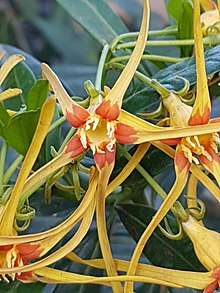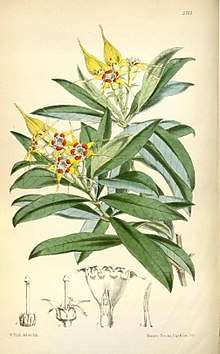Strophanthus speciosus
| Strophanthus speciosus | |
|---|---|
 | |
 | |
| Strophanthus speciosus[1] | |
| Scientific classification | |
| Kingdom: | Plantae |
| (unranked): | Angiosperms |
| (unranked): | Eudicots |
| (unranked): | Asterids |
| Order: | Gentianales |
| Family: | Apocynaceae |
| Genus: | Strophanthus |
| Species: | S. speciosus |
| Binomial name | |
| Strophanthus speciosus | |
| Synonyms[2] | |
| |
Strophanthus speciosus grows as either a shrub up to 4 metres (13 ft) tall or as a liana up to 16 metres (52 ft) long, with a stem diameter up to 3 centimetres (1.2 in). Its flowers feature a white turning orange corolla, red-streaked on the inside. Vernacular names for the plant include "common poison rope" and "forest poison rope ". Habitats are forests and their margins from 300 metres (980 ft) to 1,400 metres (4,600 ft) altitude. Local medicinal uses of S. speciosus include snakebite treatment. The plant has also been used as arrow poison.[3] S. speciosus is native to Zimbabwe, South Africa and Swaziland.[2][3] As with other species of Strophanthus it contains the cardiac glycoside strophanthin - plants of allied genera contain similar compounds.
References
- ↑ 1868 illustration by Walter Hood Fitch (1817 – 1892) - Curtis's Botanical Magazine v94 (1868) Plate 5713
- 1 2 3 "Strophanthus speciosus". World Checklist of Selected Plant Families (WCSP). Royal Botanic Gardens, Kew. Retrieved 2 August 2017.
- 1 2 Medicinal Plants. PROTA. 2008. p. 560. ISBN 978-9-05782-204-9.
| Wikimedia Commons has media related to Strophanthus speciosus. |